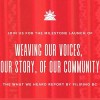Vancouver-based Fil-Cans celebrate ‘Ati-Atihan Festival’
VANCOUVER, British Columbia — Some 500 members of ther Filipino-Canadian community here gathered at the Renfrew Community Center last January 7 to celebrate this year’s “Ati-Atihan Festival 2012”. Organized by the Aklan AtiAtihan Association of B.C. led by president Bobby Refol Jr., the event reenacted “The Barter of Panay” directed by Aklan native Remy Adante. Ati-Atihan means “to be like an Ati.” The Atis were the aboriginal inhabitants of Panay Island, where Aklan is found – they are short, dark-skinned and kinky-haired people.
Adante said legend tells us that the celebration had its beginnings sometime in the 13th century with the arrival of a group of Malays from Borneo, headed by their chieftain Datu Puti.
‘STREET DANCING’
Refol and the Board of Directors led by vice president Don molo, secretary Janet Hidalgo, treasurer Deuselo Tocol, assistant secretary Roy Motus, business managers Glenn Sucro and Guiseppi Martelino, PROs Neil Ingalla and Jun Oro acted as actors and actress in a short program followed by “street dancing” in the tune of drums. They were joined by directors Jennifer Panado, Nonong Tordecillas, Lito Piano, Joy Tocol, Joan Ingalla, and Donalie Montoya. Four “tribes” joined the parade: Altavas, Makato, Kalancia, and Kalibo, Aklan’s capital town.
The cast acted like they were fleeing from the tyranny of Datu Makatunaw at home and were looking to buy some land where they can stay. They were welcomed by the natives of the place, headed by their King Marikudo and Queen Maniwangtiwang, who offered them the land they needed.
GOLD
In exchange for a solid gold hat or salakot for their king and a necklace for their queen, the Atis decided to give up their lands in the coastal area to the Borneans or Maraynon, as the Atis came to call them, and to move upland. This transaction came to be known in Philippine history as the “Barter of Panay.” Before the Atis left, however, and in appreciation of the hospitality they received, Datu Puti ordered his people to paint and dress themselves like Atis and to hold a feast with their benefactors in celebration of their newly-established friendship.
This relationship was strengthened in the succeeding days when, as a result of strong monsoon rains wiping out hillside crops, the Atis came down to the lowlands to ask for food. The Maraynon who had a good harvest shared their blessings with the Atis.
The Atis danced and sang in gratitude for the help they received. Every year since then, the mountain people have come to ritually solicit food through song and dance. The lowlanders got into the spirit of this continuing friendship by daubing their faces with soot and dancing with the Atis. This annual ritual eventually developed into the Ati-Atihan folk festival.
RELIGIOUS
From a folk celebration, the Ati-Atihan took on a religious character after the arrival of the Spaniards in 1521 and the adoption by many Christianized Filipinos of the Santo Nino as their patron saint following the recovery of the miraculous image in Cebu in the year 1565.
The coming of the Santo Nino into the Ati-Atihan fiesta is said to have started with the intervention of the first encomiendero of Aklan, Don Antonio Flores. He made arrangements with Datu Malanga and Datu Madayog to have their then existing native celebration be dedicated to the Santo Nino. With the subsequent adoption by the Aklanons of the Santo Nino as their patron saint, the celebration of the feast of the Santo Nino was made to coincide with the Ati-Atihan festival.
The Spaniards encouraged the Ati-Atihan festival despite its origins as a pagan ritual because, given the remoteness of native settlements and the difficulty of travel, the festival enabled the religious orders to reach out to thenatives.
FLOCK
The natives would flock to the town center or cabecera, giving the Church an opportunity to indoctrinate them in Christianity. The festival offered religious processions, dances, music, and theatrical presentations to the people. Although it may be “sacred or profane blended together … it is highly doubtful that the natives were aware of the ceremony’s elaborate liturgical symbolism, but they evidently relished the pageantry involved.”
Thus, the original commemoration of a land barter and thanksgiving for the post-monsoon harvest has turned into a feast day for the Santo Nino. And since then, the image of the Santo Nino has become part of the festival, and to the shouts of “Hala Bira!” was added the chant “Viva Senor Santo Nino!”
Written By: ALEX P. VIDAL from Philippine Asian News Today
 Canada
Canada





